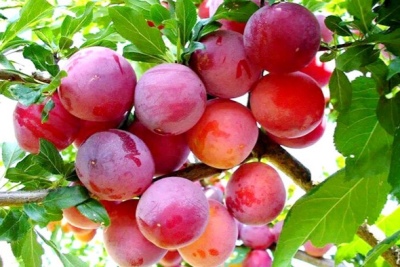
- Authors: A.N. Venyaminov, A.T. Turovtseva
- Appeared when crossing: Zarya x Giant
- Growth type: medium-sized
- Crown: sprawling
- Tree height, m: 2-2,5
- Fruit size: large
- Fruit weight, g: up to 40
- Fruit shape: rounded
- Fruit color: bright orange in technical maturity, maroon in consumer
- Pulp (consistency): dense, juicy, crispy
In a small garden area, compact plum trees will comfortably grow, which can also give bountiful harvests. These types include the mid-ripening plum Souvenir of the East of domestic selection.
Breeding history
Plum Souvenir of the East appeared in Voronezh ASU. Russian scientists A. T. Turovtseva and A. N. Venyaminov worked on the breeding of the variety. To get a new variety, several East Asian species were used - Zarya and Gigant. The most productive culture, growing in the middle zone of the Russian Federation.
Description of the variety
The souvenir of the East is a medium-sized tree, growing up to 200-250 cm. The tree has spreading branches, a regular crown with a moderate thickening of green foliage with dullness, as well as strong red-brown shoots. The tree blooms quite early: the end of April - the first week of May. At this time, the crown is densely covered with small light flowers without a bright aroma.
Fruit characteristics
The variety belongs to large-fruited crops. The average fruit weight is 40 grams. The shape of the plums is correct - rounded, with a smooth surface, on which a matte bloom and a pronounced seam are expressed. Ripe plums are characterized by a beautiful color - maroon, and at the stage of technical maturity - bright orange. The skin of the fruit is of moderate density, not hard.
The purpose of the table variety is that plums are eaten fresh, juices and jams are made from them. The fruits are not suitable for canning, since they are prone to boiling. The transportability of the plums is good, and only unripe fruits, taken in a state of technical ripeness, are endowed with long-term keeping quality.
Taste qualities
Plum is characterized by excellent taste and excellent presentation. The yellowish-orange pulp has a firm, fleshy and juicy crunchy texture. The taste is dominated by sweetness, with a barely noticeable sourness, which are harmoniously combined with a strong spice. Plums have a pronounced, fruity aroma. Inside the fruit there is a small bone, with moderate separation from the pulp. The pulp contains more than 13% sugars and less than 1% acids. Those who have tried plums claim that they are similar in taste and appearance to peaches.
Ripening and fruiting
The variety represents the class of plums with medium ripening times. The tree begins to bear fruit in the 4th year after planting. The first fruits can be tasted in the second half of August. The active fruiting phase occurs in the last week of August - early September. Fruiting at the tree is stable and annual.

Yield
The yield indicators of the variety are excellent. Having provided good care, the fruit crop will certainly thank you with an excellent harvest - from 26 to 45 kg per tree per season.
Self-fertility and the need for pollinators
Plum is self-fertile, therefore it needs pollinating trees.It is recommended to use in this case the Giant plum variety or the diploid cherry plum. In addition, other early plum varieties blooming simultaneously with the Souvenir of the East variety are suitable as donor trees.
Growing and care
The souvenir of the East does not require complicated agricultural technology, but the choice of the site and the soil must be carefully considered. The site must be sunny, clean, protected from drafts. The best will be light loams, chernozem and sod-podzolic soil with a neutral level of acidity. Due to the fact that the root system does not like stagnant moisture, there should be a deep bed of groundwater on the site.
Planting of seedlings can be carried out both in the spring (before the growing season) and in the fall (before stable frosts). The distance between trees should be 3-4 meters. It does not get along well in the same area of the plum with cherry, sweet cherry and pear.
The agricultural technology of a fruit tree consists of a chain of activities: regular watering, mineral dressing, spring and autumn pruning of branches, crown formation, weeding and loosening of the soil, protection from insects and fungus, as well as preparation for winter - mulching of the near-root zone. In regions with harsh winters, shelter with burlap or agrofibre will be needed.




Disease and pest resistance
The immune system of the fruit crop is good, so it rarely gets sick. The only disease that plum is exposed to is clasterosporium disease. Timely spraying will provide protection from insects.

Despite the fact that plum is considered more hardy than many fruit trees, it is not immune from diseases. It is attacked by viral, fungal and bacterial infections, and parasitic insects harm it. It is necessary to notice and recognize the signs of plum disease in time. They are easier to deal with and defeat early on. Well, in order to protect the garden tree from such a misfortune in the future, preventive procedures can be carried out.
Resistance to soil and climatic conditions
Plum is frost-resistant, easily tolerates short-term drought and sharp temperature fluctuations. In addition, the tree is not afraid of heat, but gusty winds and excess moisture can negatively affect the development and yield indicators.



































































